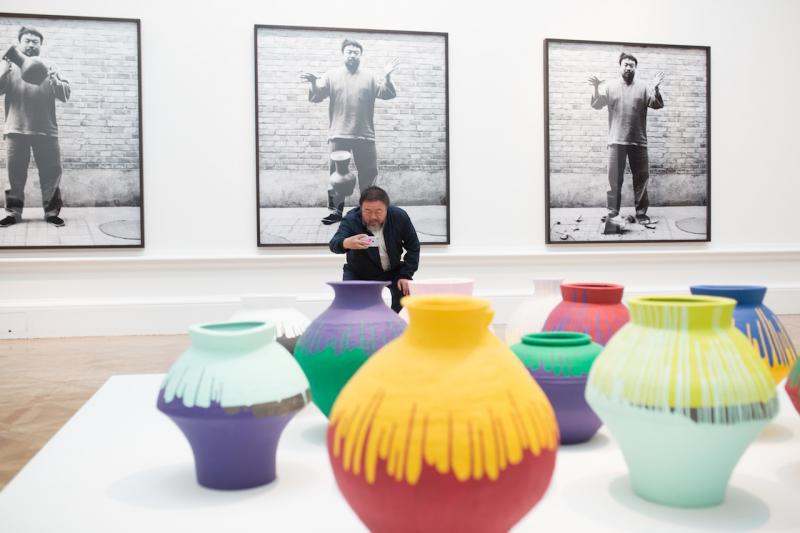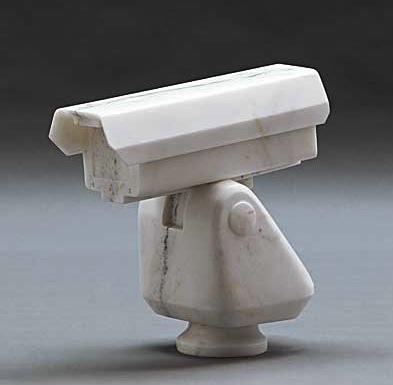Ai Weiwei, Royal Academy | reviews, news & interviews
Ai Weiwei, Royal Academy
Ai Weiwei, Royal Academy
The Chinese activist is more powerful as a symbol of dissidence than as an artist

Ai Weiwei’s first major survey in the UK is a better looking exhibition than I had anticipated, but what it gains in looks it sadly lacks in substance – backstory and information not being quite the same.
What looks like a battered leather armchair incongruously placed by the side of this temporary copse actually turns out to be carved from black marble. You’d never have guessed, but then the trees aren’t what they seem either, since they are made from the recycled remnants of felled trees, stripped and bolted together.
But often, as we find here, it’s hard to gauge what meaningful relationship one object has to another. Ai’s blandly surreal juxtapositions seem so often to be half-hearted mise en scènes in search of a stage set. One gallery is filled with things in white marble: a life-size pushchair on a square of grass, with a surveillance camera (a recurring motif in Ai’s work, referring to the constant surveillance of his studio; pictured below) on a plinth in one corner, a camcorder in another, and a gas mask nearby. The tufts of marble grass are huge, so appear out of kilter with the pram. This looks like a miscalculation rather than a deliberately sinister framing. There’s something rather bathetic about it.
 Ai is, of course, better known for his defiance of the Chinese authorities than for his work, although his Turbine Hall installation of porcelain sunflower seeds at Tate Modern was widely seen and written about when it was shown in 2010, both because he’d already achieved recognition as a celebrity dissident and because the piece soon proved a health and safety hazard. It was swiftly cordoned off from the public due to dust emissions when crunched by so many feet. The piece itself was underwhelming, though many spoke in hallowed terms of its apparent allusion to the Great Famine under Mao and the sunflower seed as a symbol of Chinese resilience and social life. Often it was the only reliable food source during periods of great hardship.
Ai is, of course, better known for his defiance of the Chinese authorities than for his work, although his Turbine Hall installation of porcelain sunflower seeds at Tate Modern was widely seen and written about when it was shown in 2010, both because he’d already achieved recognition as a celebrity dissident and because the piece soon proved a health and safety hazard. It was swiftly cordoned off from the public due to dust emissions when crunched by so many feet. The piece itself was underwhelming, though many spoke in hallowed terms of its apparent allusion to the Great Famine under Mao and the sunflower seed as a symbol of Chinese resilience and social life. Often it was the only reliable food source during periods of great hardship.
But it struck me that there was something insensitively tone-deaf about the project. There were one hundred million individual seeds in all, and Ai had recruited 1,600 workers over a period of two and a half mind-numbing years to make and paint each tiny, hidden porcelain seed. Marina Abramovič’s foray into Zen mindfulness as showy performance art, in which she instructed participants at the Serpentine Gallery to spend hours counting rice, pales in comparison. Self-negation in pursuit of enlightenment is not quite the same as self-negation in the service of the artist’s ego.
It’s grim, too, when one thinks of all those pots, some ancient, some prehistoric, that Ai’s dipped in industrial paint, or else painted with a Coca-Cola logo or deliberately smashed to the ground, having recorded the smash-up with a blown-up photo triptych: we see Ai placidly hold the pot, Ai release the pot, then the pot smashed to smithereens at his feet (see main picture). The iconoclasm feels borrowed, like so much of his work feels borrowed. It’s the derivative language of Duchamp, minimalism, protest art and Pop and it feels stale in his hands, as if the ideas the work is meant to embody are detached from the work itself.
This feeling of the idea being “tagged on” but not embodied may be because Ai’s activism comes way before his art, though Ai himself says he makes no distinction between his activism and his art. With a central work like Straight, we learn that all those rusted steel rods are the rebars from jerry-built schools that collapsed in the Sichuan earthquake of 2008. Sixty-nine thousand people were killed, many of them children. Ai bought the steel reinforcing bars in bulk anonymously, and had them straightened. As part of the piece the names of some of those who died are listed on one long wall.
Before he made the piece, Ai, along with some of the parents, had set up the Citizens' Investigation into the earthquake, collecting the names of the children and publishing them on his blog. The authorities, who were keen to play down the numbers killed, shut the blog down. While attending the trial of an earthquake activist, police broke down the door to his hotel room in the middle of the night and beat him up. He recorded much of this with a camera. As a result of the attack he suffered a brain haemorrhage and needed an emergency operation. He recorded his recovery in hospital, too.
Ai is undoubtedly brave for continually defying the authorities. His arrest in 2011 at Beijing airport and subsequent incarceration for 81 days at a secret location (a trumped up tax evasion charge followed his release) has given rise to a recent work, a series of six metal boxes containing a half life-sized model of his cell, featuring realistic half life-sized models of himself and his two guards. In his tiny cell – meticulously rendered here as dioramas viewed through glass aperatures – the prison guards kept a watchful eye on him 24-hours a day, but were instructed to not speak to him. Given no date for his release, with no actual charges at that point that he could deny, and having no contact at all with the outside world, one can only imagine the acute psychological stress he underwent. But there’s both a seductive enchantment and an impassive remoteness in such a literal and colourful illustration. Like those toy town miniature villages amalgamating famous landmarks this feels almost cute, and it's robbed of any real power.
Share this article
Add comment
The future of Arts Journalism
You can stop theartsdesk.com closing!
We urgently need financing to survive. Our fundraising drive has thus far raised £49,000 but we need to reach £100,000 or we will be forced to close. Please contribute here: https://gofund.me/c3f6033d
And if you can forward this information to anyone who might assist, we’d be grateful.

Subscribe to theartsdesk.com
Thank you for continuing to read our work on theartsdesk.com. For unlimited access to every article in its entirety, including our archive of more than 15,000 pieces, we're asking for £5 per month or £40 per year. We feel it's a very good deal, and hope you do too.
To take a subscription now simply click here.
And if you're looking for that extra gift for a friend or family member, why not treat them to a theartsdesk.com gift subscription?
more Visual arts
 'We are bowled over!' Thank you for your messages of love and support
Much-appreciated words of commendation from readers and the cultural community
'We are bowled over!' Thank you for your messages of love and support
Much-appreciated words of commendation from readers and the cultural community
 Folkestone Triennial 2025 - landscape, seascape, art lovers' escape
Locally rooted festival brings home many but not all global concerns
Folkestone Triennial 2025 - landscape, seascape, art lovers' escape
Locally rooted festival brings home many but not all global concerns
 Sir Brian Clarke (1953-2025) - a personal tribute
Remembering an artist with a gift for the transcendent
Sir Brian Clarke (1953-2025) - a personal tribute
Remembering an artist with a gift for the transcendent
 Emily Kam Kngwarray, Tate Modern review - glimpses of another world
Pictures that are an affirmation of belonging
Emily Kam Kngwarray, Tate Modern review - glimpses of another world
Pictures that are an affirmation of belonging
 Kiefer / Van Gogh, Royal Academy review - a pairing of opposites
Small scale intensity meets large scale melodrama
Kiefer / Van Gogh, Royal Academy review - a pairing of opposites
Small scale intensity meets large scale melodrama
 Jenny Saville: The Anatomy of Painting, National Portrait Gallery review - a protégé losing her way
A brilliant painter in search of a worthwhile subject
Jenny Saville: The Anatomy of Painting, National Portrait Gallery review - a protégé losing her way
A brilliant painter in search of a worthwhile subject
 Abstract Erotic, Courtauld Gallery review - sculpture that is sensuous, funny and subversive
Testing the boundaries of good taste, and winning
Abstract Erotic, Courtauld Gallery review - sculpture that is sensuous, funny and subversive
Testing the boundaries of good taste, and winning
 Edward Burra, Tate Britain review - watercolour made mainstream
Social satire with a nasty bite
Edward Burra, Tate Britain review - watercolour made mainstream
Social satire with a nasty bite
 Ithell Colquhoun, Tate Britain review - revelations of a weird and wonderful world
Emanations from the unconscious
Ithell Colquhoun, Tate Britain review - revelations of a weird and wonderful world
Emanations from the unconscious
 Rachel Jones: Gated Canyons, Dulwich Picture Gallery review - teeth with a real bite
Mouths have never looked so good
Rachel Jones: Gated Canyons, Dulwich Picture Gallery review - teeth with a real bite
Mouths have never looked so good
 Yoshitomo Nara, Hayward Gallery review - sickeningly cute kids
How to make millions out of kitsch
Yoshitomo Nara, Hayward Gallery review - sickeningly cute kids
How to make millions out of kitsch
 Hamad Butt: Apprehensions, Whitechapel Gallery review - cool, calm and potentially lethal
The YBA who didn’t have time to become a household name
Hamad Butt: Apprehensions, Whitechapel Gallery review - cool, calm and potentially lethal
The YBA who didn’t have time to become a household name

Comments
I don't agree with everything
Of course the iconoclasm and
Interesting arguments from
Interesting arguments from both Fisun and 'Feyza', proving that Ai's concepts and their execution can defy easy pigeonholing. Nevertheless, I rather liked the idea that the materials and their transformation could be easily grasped by thousands (millions?) of young people who flocked to the exhibition (annoying as constantly finding oneself in the way of the relentless amateur photographers certainly was). And, yes, merely being an heroic dissident, which Ai certainly is, doesn't make him a great artist necessarily, but I felt an authenticity throughout, and - as with the Kiefer exhibition - a magnificent use of those huge white Royal Academy spaces.
I'd agree with the reviewer,